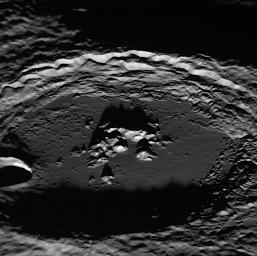Named in 2008 for the Brazilian painter Tarsila do Amaral, Amaral crater was imaged during MESSENGER's first Mercury flyby and discovered to contain bright central peaks that were relatively blue in color compared to the surrounding terrain. The peaks resembled those of Eminescu in color, now known to be the location of an impressive collection of hollows. This spectacular image of Amaral highlights the topography of the peaks inside the crater but doesn't show wide-spread hollows as seen within Eminescu, though there may be a hint that perhaps the bright tips of Amaral's peaks do host hollows.
This image was acquired as a high-resolution targeted observation. Targeted observations are images of a small area on Mercury's surface at resolutions much higher than the 250-meter/pixel (820 feet/pixel) morphology base map or the 1-kilometer/pixel (0.6 miles/pixel) color base map. It is not possible to cover all of Mercury's surface at this high resolution during MESSENGER's one-year mission, but several areas of high scientific interest are generally imaged in this mode each week.
Date acquired: February 04, 2012
Image Mission Elapsed Time (MET): 236873588
Image ID: 1353328
Instrument: Narrow Angle Camera (NAC) of the Mercury Dual Imaging System (MDIS)
Center Latitude: -26.44.°
Center Longitude: 118.2.° E
Resolution: 80 meters/pixel
Scale: Amaral has a diameter of 109 kilometers (68 miles)
Orientation: North is to the left
Incidence Angle: 85°
Emission Angle: 56°
Phase Angle: 29°
The MESSENGER spacecraft is the first ever to orbit the planet Mercury, and the spacecraft's seven scientific instruments and radio science investigation are unraveling the history and evolution of the Solar System's innermost planet. Visit the Why Mercury? section of this website to learn more about the key science questions that the MESSENGER mission is addressing. During the one-year primary mission, MDIS is scheduled to acquire more than 75,000 images in support of MESSENGER's science goals.
These images are from MESSENGER, a NASA Discovery mission to conduct the first orbital study of the innermost planet, Mercury. For information regarding the use of images, see the MESSENGER image use policy.

 Planetary Data System
Planetary Data System












